Digital discovery
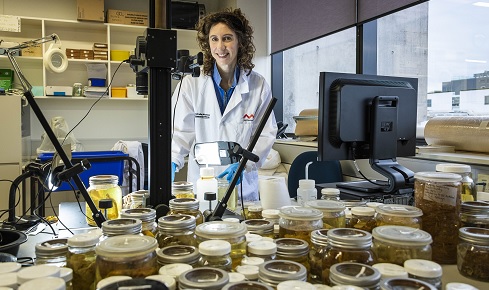
February 22nd 2022
Laetitia Gunton explains the painstaking work required to digitise millions of museum specimens – and why it’s worth the effort
Walk into any natural history museum and the diversity of specimens and objects on show is amazing, yet only a small fraction of the contents of the museum is on public display. Behind the public galleries, often in large temperature-controlled rooms or in offsite locations, floor-to-ceiling mobile shelving units are crammed with jars and boxes of specimens and cultural objects. Natural history collections worldwide are estimated to house as many as 2.5 billion specimens[1].
In the past access to these collections and the use of objects and data held by museums was restricted to a small number of museum staff, on-site visitors or through the organisation of specimen loans. Now digitisation – the process of creating accessible digital representations of analogue materials – is opening up a treasure trove of museum data to the world.
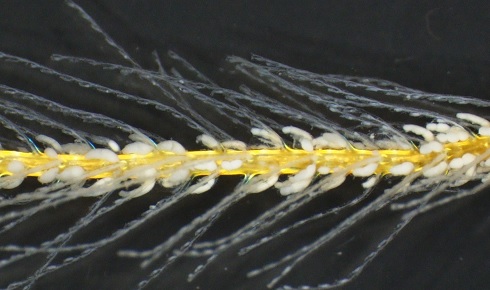 A hydrozoan specimen photographed as part of the Australian Museum’s digitisation project
A hydrozoan specimen photographed as part of the Australian Museum’s digitisation projectThese priceless collections are a subsample of our Earth though time and can be used to answer fundamental, large-scale evolutionary, ecological and biogeographic questions, as well as develop robust taxonomies and catalogue biodiversity[2]. Museums provide rare historical data, which is used to inform predictive models to understand future environmental change[3,4]. Museums hold the information to help save the world,and creating a digital record of specimens and associated data enormously enhances access to this information.
External researchers, data analysts and citizen scientists can search and access the data at any time and from anywhere with an internet connection. Images of specimens, including those not on display, can be viewed and shared on social media, maximising public engagement with the work of museums and natural history. Having an online digital database creates a two-way conversation between the public and museum staff about the objects, as members of the public can comment on objects and their identifications.
It even helps future-proof the collections by reducing the need to handle the objects as frequently, reducing wear and tear. The disruption to in-person meetings and specimens loans caused by COVID-19 has only added to the value of being able to send digital images to experts around the world.
Digitising sea life
The Australian Museum in Sydney, Australia, is in the process of digitising its collection of over 21 million specimens and cultural objects. Not only are the museum objects scientifically and culturally important, but so too is the data attached to them. As well as a description of what it is, information on where and when the object was collected and by whom provides valuable context.
During the digitisation project, all the hard copy data (labels and registers) will be transcribed onto the museum’s electronic database and combined with selected digital images (photographs or 3D scans) of the objects. This information will then be fed into publicly available global databases such as the Atlas of Living Australia and the Global Biodiversity Information Facility.
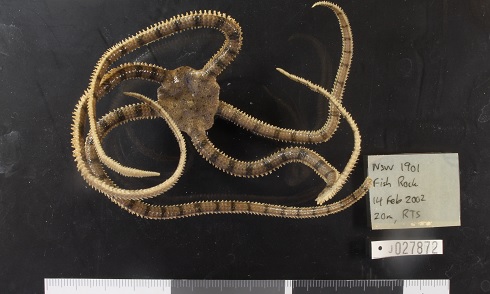 A preserved brittle star (Ophiuroidea) specimen photographed as part of the Australian Museum’s digitisation project
A preserved brittle star (Ophiuroidea) specimen photographed as part of the Australian Museum’s digitisation projectThe museum’s marine invertebrate collection is one of its most diverse collections, with registers cataloguing collections from 1883. It is estimated that there are over 511,000 samples in this collection alone, including worms, crabs, lobsters, shrimp, prawns, corals, jellyfish, sea stars, sea urchins and sponges, to name just a few – but fewer than 50% of specimens have been fully documented. Excitingly, during digitisation we have already uncovered specimens of species that are poorly known and represent new distribution records, adding to the understanding of their biology.
You might imagine digitising museum specimens to be a quick and simple process, but there is more to it than photographing the ‘good side’ of a lobster. First we have to select a phylum to digitise. Choosing which group to start with depends on multiple factors such as existing levels of digitisation, levels of specimen identification, availability of taxonomic expertise, and number and size of specimens. Locating and accessing the specimens themselves is not always easy, either: the majority of our wet collection is stored over two levels in the Spirit House, a purpose-built storage facility attached to the original museum building. Built in the 1970s, the main route of entry is through a ‘secret’ door in the goods lift.
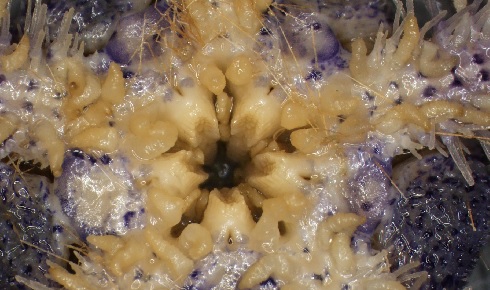
Preparation anxiety
Once the specimens are bought over to the laboratory, we must prepare them for photography. They are generally kept in ethanol- or formalin-filled jars, some of which are over 100 years old and can be extremely difficult to open. In the worst-case scenario, jars need to be broken open to access the specimen inside. Jars may also contain mixed lots (multiple specimens from different species), which need to be sorted into taxa. Some jars contain hundreds of specimens.
Images are taken of the specimens along with all the labels from the jar. Depending on the group that is being worked on, different images of different structures of the animals will be required. When imaging a brittle star, the mouth parts are important diagnostic features for species identification, whereas when imaging sponges, photographs of the oscula (openings) are important.
If the specimens are only identified to phylum level, we use microscopes and scientific literature to try to identify them further. If we don’t have the specialist knowledge to do this at the museum, we collaborate with an external taxonomic specialist of the group. Then we register the specimens and upload the images to the museum’s electronic database. The registered specimen must be matched with collection event information (who collected the specimen, when and where from).
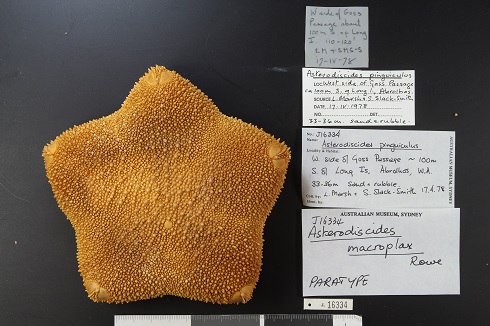 A sea star (Asteroidea) specimen photographed as part of the Australian Museum’s digitisation project
A sea star (Asteroidea) specimen photographed as part of the Australian Museum’s digitisation projectConservators at the museum are then consulted about the best way to ensure the longevity of the specimens in the collection. New jar labels are printed with updated identifications and collection information. The specimen jar is topped up with ethanol and the glassware is changed, if required. Then we move the specimen back to the permanent collection. Even this is no simple task: the marine invertebrate collection is growing each year and space is at a premium. Replacing a jar can involve a lot of reshuffling – sometimes hundreds of jars need to be moved to fit the new ones in.
Spongy specimens
We recently tackled the sponges (Porifera). Specimens preserved in ethanol can be rather smelly and exude a thick mucus, not unlike that produced by Slimer from Ghostbusters. In life this is a characteristic that sponges can combine with chemical defences to ward off predators. We have registered more than 1,500 sponge specimens and have worked with a sponge specialist from the Queensland Museum to identify more than 100 of these from the images produced, resulting in some interesting findings.
Five species – Suberea clavata, Cinachyrella schulzei, Hicksonella expansa, Coscinoderma nardorus and Clathria (Thalysias) virgultosa – were new records for the collections and the Suberea clavata specimens were from New South Wales, an area where this species has rarely been found. One uncatalogued sponge we discovered was collected in 1888 from Port Phillip, Victoria – a specimen that had been in the collections for 133 years.
The next group we are tackling is the brittle stars (Ophiuroidea). Closely related to sea stars, as their name suggests they are very fragile. An additional challenge is their arms are often tangled up together like the children’s game ‘Barrel of Monkeys’. As with the sponges, we are working with taxonomist specialists to identify these specimens to species level. We have also been taking digital photographs of important specimens that have been requested by scientists around the world. This has assisted with their studies describing new species of crustaceans, sea stars and hydrozoans. We expect many more discoveries during the process of digitisation and we are very excited to dive in and explore the collection further.
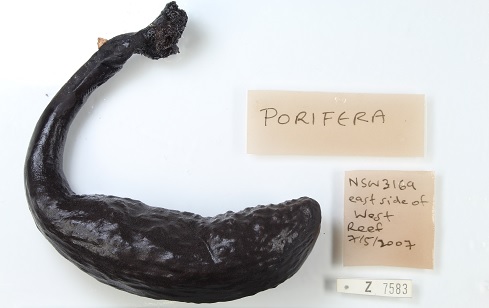 A Suberea clavata specimen photographed as part of the Australian Museum’s digitisation project
A Suberea clavata specimen photographed as part of the Australian Museum’s digitisation projectDigitisation will never replace collections of physical objects. If a picture is worth a thousand words, then a physical specimen is worth a million words. Identification to species, genus or family level for many marine invertebrates is generally not possible with a single image, and may require multiple images of specific microscopic features or only be possible by inspecting and/or dissecting the physical specimen. Furthermore, identifying specimens to species level often relies heavily on trained taxonomic specialists and researchers donating their time.
We encourage all researchers to browse and access the museum data online. You can find out more about the Australian Museum marine invertebrate collections on the museum website and about specimens in the collections at the Atlas of Living Australia.
If you would like to get involved and help transcribe the Australian Museum’s digital collections, see the DigiVol website.
Research has found that digitising London’s Natural History Museum’s 80 million objects could contribute over £2bn to the global economy. The figure was estimated from the value of biodiversity and invasive species research and the safeguarding of agricultural crops made possible by digitising the museum’s collections, one of the largest and most historically and geographically diverse in the world. Working in collaboration with Diamond Light Source, the UK’s national synchrotron at Harwell science campus, it is hoped that researchers will be able to digitise up to 1,000 insects per day in high-resolution 3D.
Dr Laetitia Gunton is the digitising technical officer in the Marine Invertebrate department at the Australian Museum, Sydney, Australia.
1) Duckworth, W. D. et al. Preserving Natural Science Collections: Chronicle of our Environmental Heritage (National Institute for the Conservation of Cultural Property, Washington, D.C., 1993).
2) Miller, S. E. et al. Building natural history collections for the twenty-first century and beyond. BioScience 70(8), 674–687 (2020).
3) Baird, R. Leveraging the fullest potential of scientific collections through digitization. Biodivers. Inform. 7, 130–136 (2010).
4) Meineke E. K. et al. Biological collections for understanding biodiversity in the Anthropocene. Phil. Trans. R. Soc. 374, 20170386 (2019).


